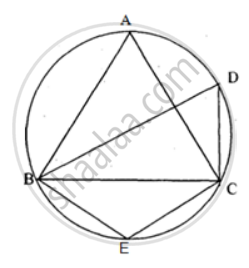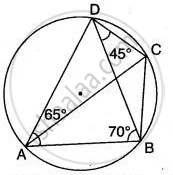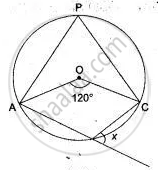Advertisements
Advertisements
Question
In the given figure, AB = AC. Prove that DECB is an isosceles trapezium.

Solution

Here, AB = AC
`=>` ∠B = ∠C
∴ DECB is a cyclic quadrilateral
(In a triangle, angles opposite to equal sides are equal)
Also, ∠B + ∠DEC = 180° ...(1)
(Pair of opposite angles in a cyclic quadrilateral are supplementary)
`=>` ∠C + ∠DEC = 180° ...[From (1)]
But this is the sum of interior angles
On one side of a transversal.
∴ DE || BC
But ∠ADE = ∠AED = ∠C ...[Corresponding angles]
Thus, ∠ADE = ∠AED
`=>` AD = AE
`=>` AB – AD = AC – AE ...(∴ AB = AC)
`=>` BD = CE
Thus, we have, DE || BC and BD = CE
Hence, DECB is an isosceles trapezium
APPEARS IN
RELATED QUESTIONS
In the figure given, O is the centre of the circle. ∠DAE = 70°. Find giving suitable reasons, the measure of:
- ∠BCD
- ∠BOD
- ∠OBD

In a cyclic quadrilateral ABCD, ∠A : ∠C = 3 : 1 and ∠B : ∠D = 1 : 5; find each angle of the quadrilateral.
If two non-parallel sides of a trapezium are equal, it is cyclic. Prove it. Or An isosceles trapezium is always cyclic. Prove it.
Prove that any four vertices of a regular pentagon are concylic (lie on the same circle).
In triangle ABC, AB = AC. A circle passing through B and c intersects the sides AB and AC at D and E respectively. Prove that DE || BC.
In the figure, ABCD is a cyclic quadrilateral with BC = CD. TC is tangent to the circle at point C and DC is produced to point G. If angle BCG=108° and O is the centre of the circle, find: angle DOC

ABCD is a parallelogram. A circle through vertices A and B meets side BC at point P and side AD at point Q. Show that quadrilateral PCDQ is cyclic.
In the figure, ∠DBC = 58°. BD is a diameter of the circle. Calculate : ∠BEC

In the given below figure,
∠ BAD = 65°
∠ ABD = 70°
∠ BDC = 45°
Find: (i) ∠ BCD, (ii) ∠ ADB.
Hence show that AC is a diameter.
If O is the centre of the circle, find the value of x in each of the following figures

